
Five Bikeshares in London
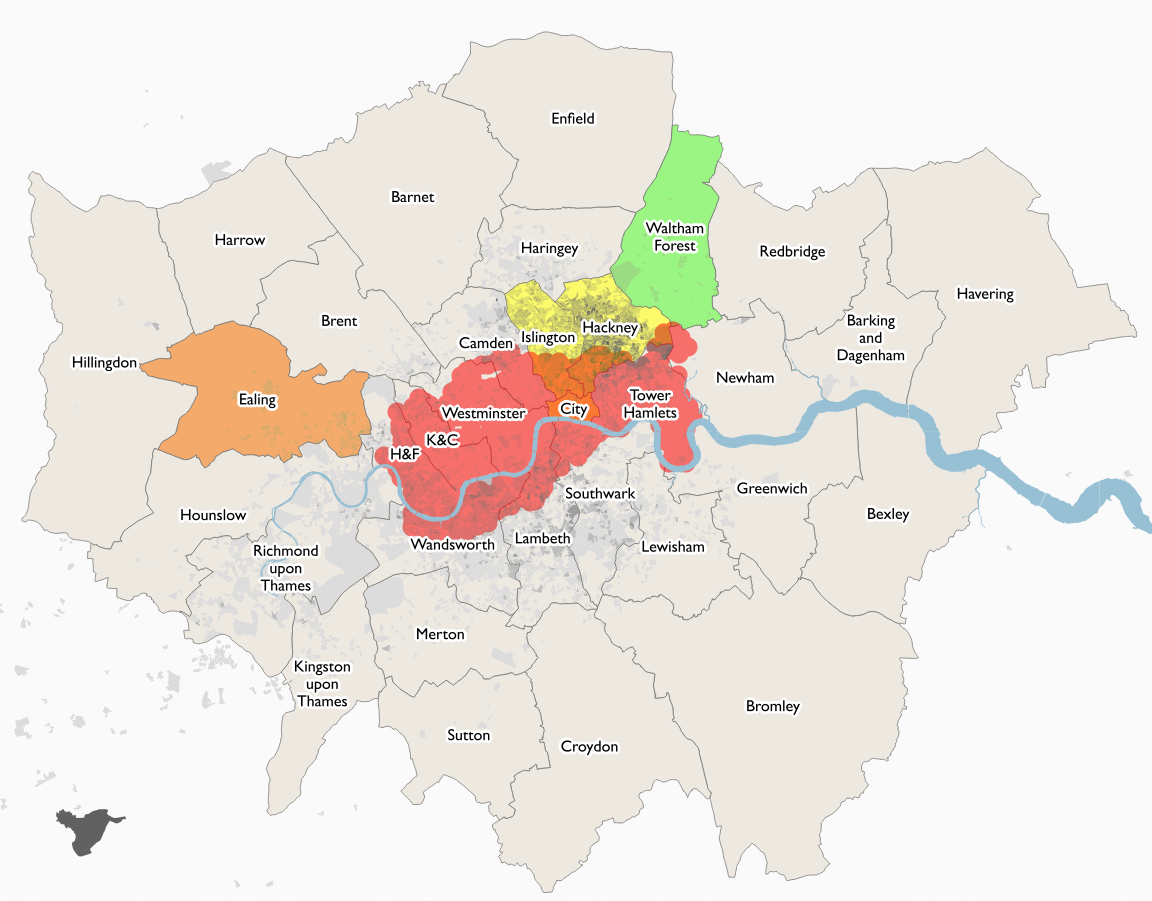
Bikeshare system coverage in London, November 2017. Shading: Proportion of people who cycle to work.
There are now five bikeshare systems operating in London:
Santander Cycles (Central London)
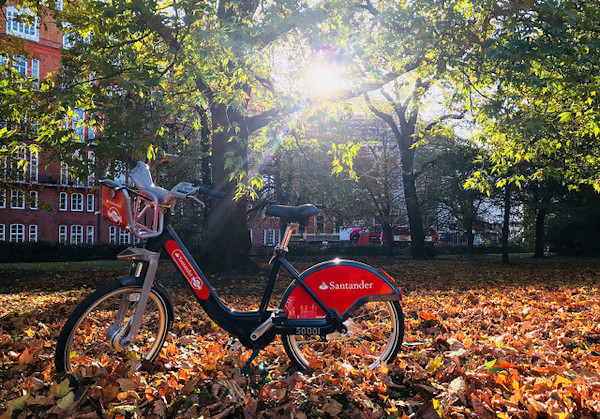 Photo: Copyright TfL.
Photo: Copyright TfL.
Santander Cycles are red, they launched in July 2010 and have around 9500 bikes on the street (12000 reported), covering an area of 110km across 11 boroughs and the City of London – this sounds impressive, but it is only 7% of London’s area (based on a 500m station buffer), and equates one bike for every 950 people in the capital. You can see the live state of the system (in terms of empty/full docking stations) on Bike Share Map. As a publically funded system, Santander Cycles have an excellent open data policy and release live docking station data, location information and historic journeys through TfL’s Open Data Portal.
Santander Cycles last week unveiled their “50000-series” bikes which are part-manufactured in the UK, with smaller wheels, bluetooth maintenance tags and a number of other enhancements, although in technology terms they still very much third-generation bikeshare bikes (dumb bike, smart dock) and the system remains expensive to use with a complicated pricing structure (£90/year or £2/day membership for journeys under half-hour, £2 per extra half-hour), with its footprint hamstrung by expansion costs – so expansions over the last few years have been very small. There have been some other innovations, such as widespread use of Blaze laser lights. Santander Cycles remains expensive and rigid, it is however the “gold standard” of bikeshare in London.
Mobike (LB Ealing)
Mobike (orange bikes) were the first dockless fourth generation* (smart bike, dumb lock) compliant (working with local authorities) system in London, which launched in Ealing in July this year – a far from obvious place to launch, as Ealing has a very low tradition of cycling in general (no dark areas in the maps shown here). However, Mobike did have UK experience before, having had a bigger and higher-profile launch in two of Greater Manchester boroughs. Mobike persevered through initial bad publicity due to vandalism by Manchester locals and can be seen on many streets of the city. Personally, I found Mobike extremely uncomfortable to cycle – their bikes have been shipped from the far east with little customisation, and their frames are designed for the far eastern rather than the European build. This is a pity, presumably the extremely cheap mass manufacturing costs of sticking with their global design were too tempting.
The Ealing launch had a reported 750 bicycles. Ealing is not an inner-city borough and the 750 bicycles serve a huge 56 square kilometres. One nice touch is that if you have a membership of the Manchester system, it will work fine in London too. Mobike is also very cheap and has a simple to understand pricing model (£29 joining fee then 50p per half-hour ride). I wish Mobike good luck but they need more comfortable bikes and to get into a borough with an established cycling tradition. Mobike, as a fully commercial operation,
does not release bikeshare open data for Ealing (dockless bikeshare data does have theoretically considerable economic value), although they have plans to release it for Manchester (likely a stipulation from the local authority there) so maybe it will come here too in time.
Ofo (LB Hackney, LB Islington and City)
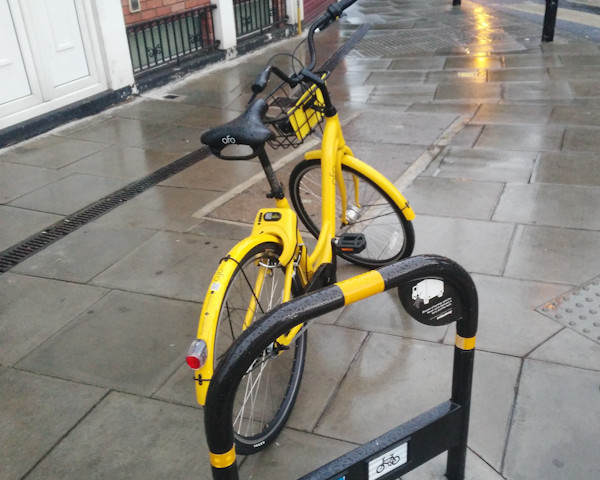
Ofo (yellow bikes) are, like Mobike, a big global player in dockless fourth generation bikeshare. They launched in Hackney – London’s spiritual home of regular cycling – in September, and have just announced (this week) an expansion to the neighbouring borough of Islington and the City of London, meaning serious commute potential of these bikes. I have ridden an Ofo bike and found it extremely comfortable – better Like Mobike, Ofo have a low joining fee, a flat rate for usage and the membership can be used in their other systems (including Cambridge in the UK). Ofo has targetted boroughs with a good cycling tradition and also is, in some parts of the boroughs, in direct competition with the incumbent Santander Cycles – the only one to do so (see map below). Hopefully this competition will lead to innovations on both sides and not damage either.
Urbo (LB Waltham Forest)
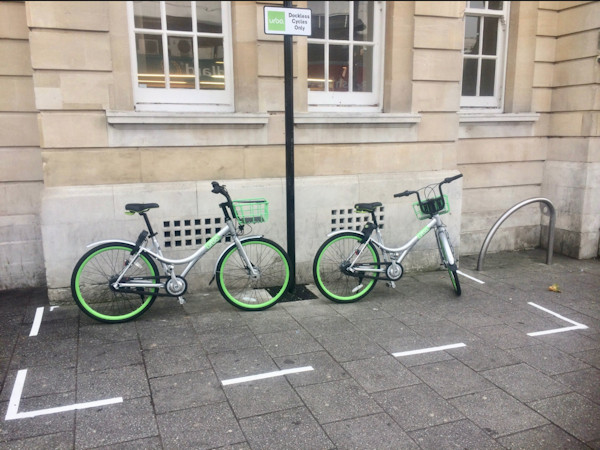 Photo: Paul Gasson on Twitter.
Photo: Paul Gasson on Twitter.
Urbo (green bikes) are another dockless fourth generation bikeshare operator. They are an Irish company, although they are buying the bikes and technology (e.g. the smart lock and the apps) from China and customising locally. Their bikes are the most attractive of the new dockless bikeshare bikes I have seen (with a nice curve design on the frame) and appear (I haven’t ridden one yet) to be similar in overall build style to Ofo’s bikes. Waltham Forest (39 sqkm in east London with some tradition of cycling, on its western edge) is their first system and it has only just launched this week. They also do not yet release open data (although they have only just launched). Ofo may be most useful for residents of Higham Hill, Poets Corner, the top of Walthamstow Village and certain other parts of the borough to get quickly to the stations on the efficient Victoria Line or Overground to central London.
Like Ofo and Mobike, Urbo have designated zones in their host boroughs and induce users (via cheaper journeys) to end their journeys in these zones. These zones come with a bespoke street sign erected by the local authority, as well as the usual taped/painted markings on the ground. It is a little surprising that Waltham Forest have included the operator logo on the signs (presumably to Urbo’s delight) as there is no good reason why other dockless systems, when they inevitably arrive here too, should use these spaces too. It is kind of like the council painting new car parking spaces on a street and putting up a sign, with the Ford logo, saying they are spaces for Ford cars only. They are just spaces on a road/pavement…
oBike (Withdrawn)
Then there’s oBike (orangey-yellow) which launched in July without coordinating with boroughs (using the Uber-style “forgiveness is easier than permission” modal), had a number of its bikes impounded by Wandsworth borough and withdrew from the capital – its bikes are lurking behind locked gates in an industrial park in Rainham so they aren’t included on the maps here. They will return, I’m sure. oBike did at least wake up boroughs, to the fourth generation revolution, and force some much-needed policy documents to be hastily released. I rode an oBike and found it more comfortable than the Mobike but not as good as Ofo, Urbo or Santander Cycles.
| System | Locations | Area /sqkm | Launch Date | # Bikes** |
|---|---|---|---|---|
| Santander Cycles | Central London | 110 | July 2010 | 9500 |
| oBike | Withdrawn | 0 | July 2017 | Was 1500, now < 50 |
| Mobike | West: Ealing | 56 | July 2017 | 750 |
| Ofo | North: Hackney, Islington & City | 37 | September 2017 | 400 |
| Urbo | East: Waltham Forest | 39 | November 2017 | 250 |
This map (an inset of the map above) shows the reach of the four systems (excluding oBike) in London. The shading behind shows the proportion of residents there who cycle to work (2011 Census data, Copyright ONS) and therefore likely enjoy good cycle infrastructure and community (e.g. cycle cafes, cycle repair workshops) that would help integrate bikeshare. Parts of Southwark and Lambeth look woefully underserved.
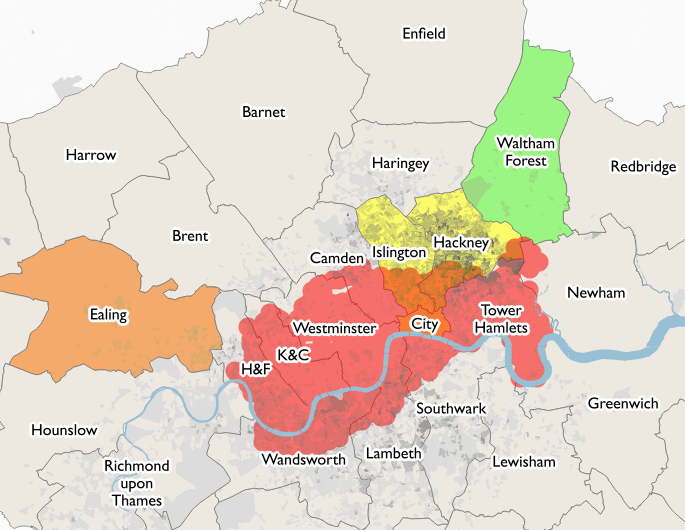
* The first generation of bikeshare systems were free bikes, left on streets for people to use. Inevitably they were stolen or broken. Second generation bikeshare systems used “dumb docking stations” where cash was used to release them. Users were therefore only out by the cash amount if they didn’t release them, and operators didn’t know where they were without visiting the docks, so again they got stolen and/or broken. Third generation bikeshare systems require the user to use credit cards (and so charge a large amount for non-return) and use smart docking stations which can report the status of themselves and their bikes. They have been very popular for the last few years, but require a large up-front investment and are very expensive to operate and maintain, so most are publically subsidised. Minor advances to these (such as GPS on some bikes, or integration with transit smart cards) are sometimes termed as fourth generation but are actually really just usability tweaks to fundamentally the same third generation concept. I am terming the new dockless systems, where the bikes know where they are (through an app, or their own communications) as fourth generation. Physical docking stations can still exist on the ground, to manage the bikes or provide a known starting location, but don’t have to be used – the “hybrid” model. True dockless systems just have tapes on the ground as “preferred” docking locations.
** For Santander Cycles, this is the typical number out on the streets, available to use. For the others, these are the reported numbers – in practice, this likely overstates the actual amounts on the streets by typically 20%
